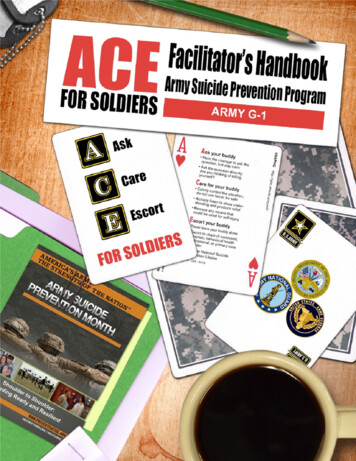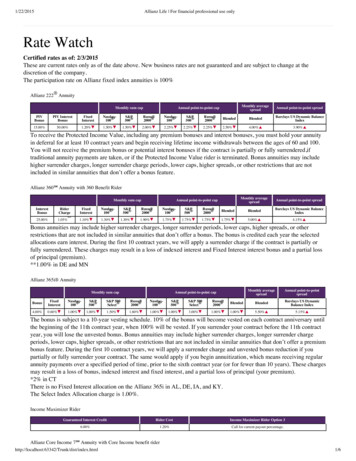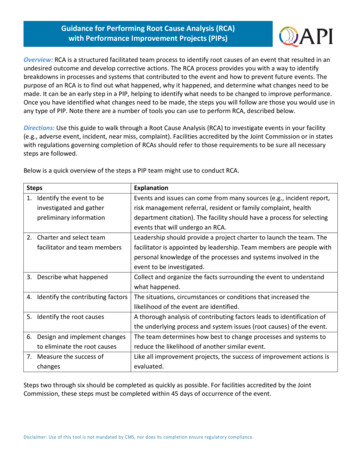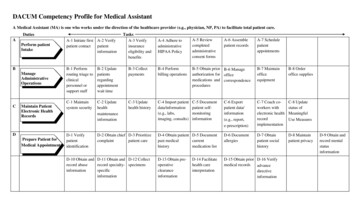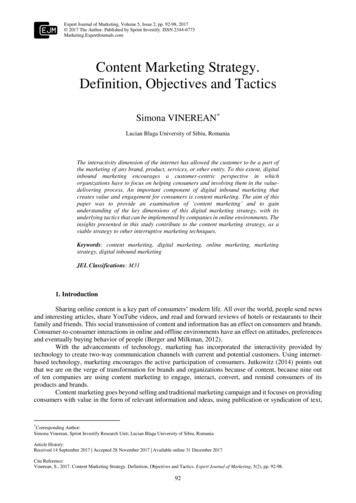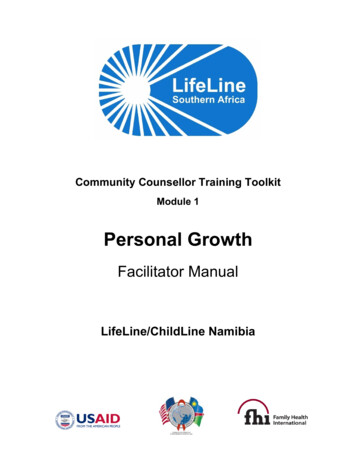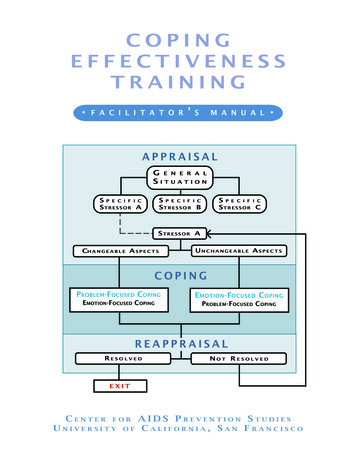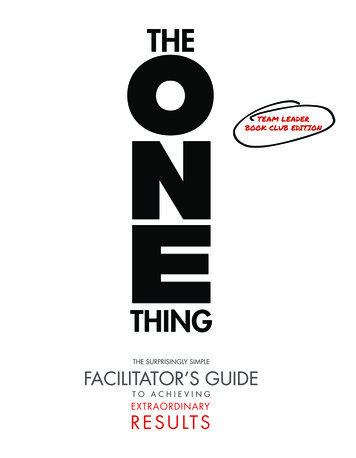
Transcription
TEAM LEADERBOOK CLUB EDITIONTHE SURPRISINGLY SIMPLEFACILITATOR’S GUIDETO ACHIEVINGEXTRAORDINARYR E S U LT S
We’ve created this book club facilitator’s guide as a way forTeam Leaders to share the principles of The ONE Thing withtheir associates and recruits. By utilizing the twelve-sessioncontent drill-down, Team Leaders will be able to lead mastermindlevel team meetings on how to live a BIG life while running asuccessful business.Facilitator Notes: While we suggest each of these sessions beallotted an hour of discussion time, this guide gives you thefreedom to go as deep as you deem necessary in any givensection of the book. Remember, these questions should beconsidered a jumping-off point.Each session is set up identically. The gray type noted with redarrows will point you to your instructions. The black text includesthe suggested topics of discussion with specific questions. Sometips to running a successful session are as follows:1. Set a limit on attendance.2. Use at least three touches (save the date, RSVP today,and don’t forget). Be sure to review each session prior toleading the group, and have fun! 2014 Rellek Publishing Partners, Ltd.THE ONE THING FACILITATOR’S GUIDE2
SESSION1Pages 6-25INTRODUCTIONTeam Leader Instructions:Introduce yourself and The ONE Thing.The ONE Thing is a #1 Wall Street Journal bestseller, and has been featured on more than 130-bestseller listsincluding The New York Times and USA Today. Written by authors Gary Keller and Jay Papasan, the bookdemonstrates that the results you get are directly influenced by the way you work and the choices you make. Itteaches you how to identify the lies that block your success and the thieves that steal time from your day. And,it shows how to identify your ONE Thing and accomplish more by doing less.Introduce today’s session and the top three talking points.1. The importance of narrowing your concentration and focus.2. How success is sequential.3. The different ways that the ONE Thing shows up in life.Suggested Questions from the Reading:1. At what time in your life—or with what aspect of your life—have you experienced success by narrowingyour concentration to ONE Thing? At what time in your life have you had the opposite experience—lesssuccess because you were spread too thin?2. What does the statement “going small” mean to you?3. Do you agree with the authors’ statement: “Extraordinary results are directly determined by how narrowyou can make your focus”? (refer to page 10)4. Where have you noticed success building on a previous accomplishment?5. What is an example of one product, service, person, passion, or skill that leads an individual or company tosuccess that was not discussed in the book? Why was that singular attribute so important to the individualor company’s ultimate success?Today’s Aha’s:Collect and discuss all Aha’s from session one’s discussion. Make note of the top three in the blanksprovided on session two.Ways to Engage After Book Club:Suggest the following action items as ways to further engage with the topics discussed today.1. Visit The ONE Thing YouTube page for an entertaining look at why narrowing your focus is importantwith the “If you chase two rabbits” video.2. Draw out your dominoes: What is the first thing you need to knock over to set great things into motion inyour life? For example, to achieve peak physical health, your first domino is get proper sleep, then eat well,and lastly, exercise regularly. 2014 Rellek Publishing Partners, Ltd.THE ONE THING FACILITATOR’S GUIDE3
SESSION2Pages 26-53EVERYTHING MATTERS EQUALLY & MULTITASKINGTeam Leader Instructions:Introduce yourself and The ONE Thing.Revisit the top three Aha’s from the prior session.1.2.3.Introduce today’s session and the top three talking points.1. There are commonly held beliefs about achieving success that are actually not true.2. The concept that the minority of your effort produces the majority of your results is known as Pareto’sPrinciple. Another commonly used term for it is the 80/20 Principle.3. Multitasking is an illusion.Suggested Questions from the Reading:1. What is the difference between a to-do list and a success list?2. Where in your life have you found the 80/20 Principle to be true—where focusing on some things matter alot more than others?3. Discuss a situation in which you have found yourself multitasking. How could you eliminate multitaskingin that scenario?Today’s Aha’s:Collect and discuss all Aha’s from session two’s discussion. Make note of the top three in the blanksprovided on session three.Ways to Engage After Book Club:Suggest the following action items as ways to further engage with the topics discussed today.1. Write out your to-do list for the week. Transform this list into a success list by prioritizing it into the thingsthat you should do.2. Watch The1Thing.com’s video “Handling Distractions,” found under Videos on the Resources tab.3. Test your multitasking ability the safe way with online games, featured on The ONE Thing Blog, April 25,2013. Share your results on social media: #theONEthing. 2014 Rellek Publishing Partners, Ltd.THE ONE THING FACILITATOR’S GUIDE4
SESSION3Pages 54-71A DISCIPLINED LIFE &WILLPOWER IS ALWAYS ON WILL-CALLTeam Leader Instructions:Introduce yourself and The ONE Thing.Revisit the top three Aha’s from the prior session.1.2.3.Introduce today’s session and the top three talking points.1. The discussion continues today on the commonly held beliefs that exist about achieving success that areactually not true.2. Success is not about having discipline in everything you do, but instead on building the right habits toreach your goals.3. Everyone has a limited supply of willpower. Decide what matters on any given day and do it first when yourwillpower is strongest.Suggested Questions from the Reading:1. What are some examples of people succeeding at high levels with significant habits rather than discipline?2. On page 57, the authors discuss how it takes an average of 66 days to build a habit. What habit, if youworked to develop it, would supercharge your productivity?3. Considering you have more willpower in the morning and less willpower in the afternoon, what activitiesshould you schedule in the first part of the day?4. How can you set up your day strategically so that you do not compromise your most important tasks anddecisions due to depleted willpower?5. On page 65 the authors write, “Willpower is like the power bar on your cell phone. As the day goes on,every time you draw on it you’re using it up.” What does this statement mean to you? When do you noticethis statement to be accurate in your daily life?Today’s Aha’s:Collect and discuss all Aha’s from session three’s discussion. Make note of the top three in the blanksprovided on session four.Ways to Engage After Book Club:Suggest the following action items as ways to further engage with the topics discussed today.1. Keep a log on how you spend your time during the day, noting your energy levels throughout the day aswell. What did you find?2. Start a new habit. Print out the 66-Day Calendar from the Tools and Forms section of the Resources tab onThe1Thing.com and challenge yourself to make a positive change in your life. 2014 Rellek Publishing Partners, Ltd.THE ONE THING FACILITATOR’S GUIDE5
SESSION4Pages 72-95A BALANCED LIFE & BIG IS BADTeam Leader Instructions:Introduce yourself and The ONE Thing.Revisit the top three Aha’s from the prior session.1.2.3.Introduce today’s session and the top three talking points.1. Balance doesn’t exist.2. Living a counterbalanced life involves letting the right things take precedence when they should.3. How success is achieved by asking big questions and setting large goals.Suggested Questions from the Reading:1. On page 75 the authors write, “In your effort to attend to all things, everything gets shortchanged andnothing gets its due.” Have you had this experience in your own life?2. Can you think of a time when you went “all-in” on a hobby, activity, or project? What were the results?3. The book says that the question of balance is really a question of priority. What kinds of priorities—inwork or life—are worth going out of balance for? For how long?4. On page 86 the book states, “No one knows their ultimate ceiling for achievement, so worrying about it is awaste of time.” What are some common limiting beliefs we see every day? What are some of your limitingbeliefs?Today’s Aha’s:Collect and discuss all Aha’s from session four’s discussion. Make note of the top three in the blanksprovided on session five.Ways to Engage After Book Club:Suggest the following action items as ways to further engage with the topics discussed today.1. Google “work-life balance” and see the number of times it shows up in a current search. Pick two articles toread on the topic and come to session five prepared to talk about the key takeaway.2. Watch The1Thing.com’s video “Are You Stealing Time from Yourself?” found under Videos on theResources tab. 2014 Rellek Publishing Partners, Ltd.THE ONE THING FACILITATOR’S GUIDE6
SESSION5Pages 96-111THE FOCUSING QUESTIONTeam Leader Instructions:Introduce yourself and The ONE Thing.Revisit the top three Aha’s from the prior session.1.2.3.Introduce today’s session and the top three talking points.1. The Focusing Question.2. How the Focusing Question works.3. How to use the Focusing Question to identify your first domino.Suggested Questions from the Reading:1. What is the Focusing Question? Why were the authors so specific in their wording?2. How does the Focusing Question help paint a path toward completing a large goal? (discuss “Life Is aQuestion,” page 104)3. When have you experienced the power of asking the wrong question?4. Based on your answers, how could replacing the wrong question with the Focusing Question produce abetter result?Today’s Aha’s:Collect and discuss all Aha’s from session five’s discussion. Make note of the top three in the blanksprovided on session six.Ways to Engage After Book Club:Suggest the following action items as ways to further engage with the topics discussed today.1. Write down your current goals. Apply the Focusing Question to each goal, tailoring it as necessary. Refer tothe Tools and Forms section of the Resources tab on The1Thing.com. Print and fill out your “Long-TermGoals” worksheet as part of this exercise. 2014 Rellek Publishing Partners, Ltd.THE ONE THING FACILITATOR’S GUIDE7
SESSION6Pages 112-129THE SUCCESS HABITTeam Leader Instructions:Introduce yourself and The ONE Thing.Revisit the top three Aha’s from the prior session.1.2.3.Introduce today’s session and the top three talking points.1. Why success starts with asking the right questions.2. How to use the Focusing Question to benefit the seven key areas of your life.3. How to find an answer to the Focusing Question.Suggested Questions from the Reading:1. What are the seven buckets in your life? (Reference figure 16 on page 114)2. How can you tailor the Focusing Question to each bucket?3. Does anyone want to share a question they have in their bucket?4. Why is it important that our Focusing Question be big and specific?5. How can you apply the quadrant exercise on page 120 to help you ask a big and specific question?6. Where does the answer to your big and specific question lie? (Reference page 124)Today’s Aha’s:Collect and discuss all Aha’s from session six’s discussion. Make note of the top three in the blanksprovided on session seven.Ways to Engage After Book Club:Suggest the following action items as ways to further engage with the topics discussed today.1. Take a look at the Focusing Questions you wrote down prior to this session and try making them big andspecific. Then write four possible answers for each big and specific question, and choose the best answerfrom the bunch. Identify behaviors you need to change or habits you need to form in order to accomplishthe goal. 2014 Rellek Publishing Partners, Ltd.THE ONE THING FACILITATOR’S GUIDE8
SESSION7Pages 130-145UNLOCKING THE POSSIBILITIES WITHIN YOUTeam Leader Instructions:Introduce yourself and The ONE Thing.Revisit the top three Aha’s from the prior session.1.2.3.Introduce today’s session and the top three talking points.1. How purpose, priority, and productivity work together for you.2. If you’re absent an answer, pick a direction to start down.3. The road to happiness.Suggested Questions from the Reading:1. How did Ebenezer Scrooge change his path through purpose, priority, and productivity?(Refer to page 139)2. Where in your life have you seen your purpose decide your priority and productivity?3. The authors tell us on page 142, “Happiness happens on the way to fulfillment.” How does purpose helpyou achieve fulfilment?4. How can you use money to finance your “big why”?Today’s Aha’s:Collect and discuss all Aha’s from session seven’s discussion. Make note of the top three in the blanksprovided on session eight.Ways to Engage After Book Club:Suggest the following action items as ways to further engage with the topics discussed today.1. Find examples of other stories, like A Christmas Carol, where the formula of purpose, priority, andproductivity work together to provide an extraordinary life. What are the characters’ purposes? 2014 Rellek Publishing Partners, Ltd.THE ONE THING FACILITATOR’S GUIDE9
SESSION8Pages 146-155GOAL SETTING & PRIORITYTeam Leader Instructions:Introduce yourself and The ONE Thing.Revisit the top three Aha’s from the prior session.1.2.3.Introduce today’s session and the top three talking points.1. At any given moment, there is only priority, not priorities.2. How Goal Setting to the Now works.3. Visualizing the process of a goal can help you achieve it.Suggested Questions from the Reading:1. When seeking to accomplish a large and specific goal, how will having multiple priorities help youachieve it?2. Gary and Jay say that purpose without priority is powerless. Why is that?3. What did you want to be when you were younger? How could you have used Goal Setting to the Nowto lead you to that occupation?4. Name a time when you visualized the process of achieving a goal. How did it help you achieve that goal?Today’s Aha’s:Collect and discuss all Aha’s from session eight’s discussion. Make note of the top three in the blanksprovided on session nine.Ways to Engage After Book Club:Suggest the following action items as ways to further engage with the topics discussed today.1. Write down your goals and domino run to get there on a piece of paper. Keep copies of this in prominentplaces—your purse or wallet, your office wall, your bedside table, etc. 2014 Rellek Publishing Partners, Ltd.THE ONE THING FACILITATOR’S GUIDE 10
SESSION9Pages 156-174THE IMPORTANCE OF TIME BLOCKINGTeam Leader Instructions:Introduce yourself and The ONE Thing.Revisit the top three Aha’s from the prior session.1.2.3.Introduce today’s session and the top three talking points.1. The importance of blocking your time for what matters most.2. Methods and strategies for setting up your time blocks.3. How to protect your time blocks.Suggested Questions from the Reading:1. Which parts of your day are most important to you? How do you currently block time for those areas?2. Based on your answers, what could you realistically time block for each day, month, year to succeed at ahigh level?3. How do you avoid distractions to focus on what matters most?4. How can you improve that? How can you protect your time blocks? For instance, discuss a time you had tonavigate a high-level request during a time block. What was the outcome?5. Discuss “Build a Bunker” on page 72.Today’s Aha’s:Collect and discuss all Aha’s from session nine’s discussion. Make note of the top three in the blanksprovided on session ten.Ways to Engage After Book Club:Suggest the following action items as ways to further engage with the topics discussed today.1. Visit The1Thing.com, and watch the video “Are You Stealing Time from Yourself?” found under theResources tab.2. Revisit pages 162-170 in the book. Time block the following on your own calendar: 1. Time block yourtime off, 2. Time block your ONE Thing, 3. Time block your planning time.3. Stick to your time blocks for a week, and note the difference in results. 2014 Rellek Publishing Partners, Ltd.THE ONE THING FACILITATOR’S GUIDE 11
SESSION10Pages 175-189MOVING TOWARD PURPOSETeam Leader Instructions:Introduce yourself and The ONE Thing.Revisit the top three Aha’s from the prior session.1.2.3.Introduce today’s session and the top three talking points.1. How to follow the path of mastery.2. Why moving from “E” to “P”—that is from being entrepreneurial to being purposeful—achievesgreater results.3. Ways you can live the accountability cycle in work and life.Suggested Questions from the Reading:1. Page 176 reads “Most assume mastery is an end result, but at its core, mastery is a way of thinking, a way ofacting, and a journey you experience.” What does this statement mean to you?2. Can you think of any examples of mastery—in your own life or the world at large?3. How can you apply the mentality of mastery to your ONE Thing?4. Gary often asks top performers: “Are you doing this to simply do the best you can, or are you doing this todo it the best it can be done?” What does this question mean to you?5. Let’s look at figure 31 on pages 180-181. What areas of your life do you approach entrepreneurially?Purposefully? How different are the results?6. What does it mean to be accountable?7. What are some ways to move toward living the accountability cycle?Today’s Aha’s:Collect and discuss all Aha’s from session ten’s discussion. Make note of the top three in the blanksprovided on session eleven.Ways to Engage After Book Club:Suggest the following action items as ways to further engage with the topics discussed today.1. Looking for an immediate accountability partner? Sign up for the My ONE Thing goal tracker to receiveautomated reminders around your biggest priority. You can also invite a friend or colleague to add a secondlevel of accountability through automated updates on your successes and struggles.2. Ready to step your accountability up to the next level? Check out the training and coaching opportunitieson The1Thing.com. 2014 Rellek Publishing Partners, Ltd.THE ONE THING FACILITATOR’S GUIDE 12
SESSION11Pages 190-207EXTRAORDINARY RESULTSTeam Leader Instructions:Introduce yourself and The ONE Thing.Revisit the top three Aha’s from the prior session.1.2.3.Introduce today’s session and the top three talking points.1. If everyone has 24 hours in a day, how come some people get so much more accomplished?2. How to identify the four thieves of productivity.3. Tips for avoiding or handling the four thieves of productivity.Suggested Questions from the Reading:1. What are the biggest distractions or time sucks in your day?2. According to the book, the first thief is the inability to say no. What does this mean to you, and how doesit affect your productivity? Have you found ways to navigate around it?3. According to the book, the second thief is the fear of chaos. What does this mean to you, and how does itaffect your productivity? Have you found ways to navigate around it?4. According to the book, the third thief is poor health habits. What does this mean to you, and how does itaffect your productivity? Have you found ways to navigate around it?5. According to the book, the fourth thief is your environment doesn’t support your goals. What does thismean to you, and how does it affect your productivity? Have you found ways to navigate around it?Today’s Aha’s:Collect and discuss all Aha’s from session eleven’s discussion. Make note of the top three in the blanksprovided on session twelve.Ways to Engage After Book Club:Suggest the following action items as ways to further engage with the topics discussed today.1. Brainstorm solutions with your team that will remove thieves from the workplace—no meetings orinterruptions between 8:00 and 11:00 a.m., set up a 66-Day Challenge around health, create a physicalbarrier (ONE Thing door knocker, signage, cube screens, etc.) to say no for you ) Have your team holdeach other accountable to following through with the plan for a week’s time. Discuss the difference inresults. 2014 Rellek Publishing Partners, Ltd.THE ONE THING FACILITATOR’S GUIDE 13
SESSION12Pages 208-223PUTTING THE ONE THING TO WORKTeam Leader Instructions:Introduce yourself and The ONE Thing.Revisit the top three Aha’s from the prior session.1.2.3.Introduce today’s session and the top three talking points.1. What is regret, and how do our decisions affect our regrets?2. Success is an inside job—all success in life starts within you first.3. Incorporating The ONE Thing into your life.Suggested Questions from the Reading:1. What does living a life of no regret mean to you?2. What steps are you taking to achieve a life of no regret? How can you help others do the same?3. Page 216 reads “Put yourself together, and your world falls into place. When you bring purpose to your life,know your priorities, and achieve high productivity on the priority that matters most every day, your lifemakes sense and the extraordinary becomes possible.” Let’s discuss.4. How are each of you going to incorporate the principles of the book into your lives?Today’s Aha’s:Collect and discuss all Aha’s from session twelve’s discussion. Send these final Aha’s out toparticipants in a wrap-up email. Ask attendees to share who they would invite to the next The ONEThing Book Club and why. Use that list to invite RSVPs to your next scheduled session.Ways to Engage After Book Club:Suggest the following action items as ways to further engage with the topics discussed today.1. Visit the1thing.com for the latest tools, content, and discussions around the principles found in the book.Be sure to stay a part of those achieving extraordinary results by sharing your stories: #theONEthing. 2014 Rellek Publishing Partners, Ltd.THE ONE THING FACILITATOR’S GUIDE 14
2014 Rellek Publishing Partners, Ltd. THE ONE THING FACILITATOR’S GUIDE 3 INTRODUCTION Team Leader Instructions: Introduce yourself and The ONE Thing. The ONE Thing is a #1 Wall Street Journal bestseller, and has been featured on more than 130-bestseller lists including The New York Tim


